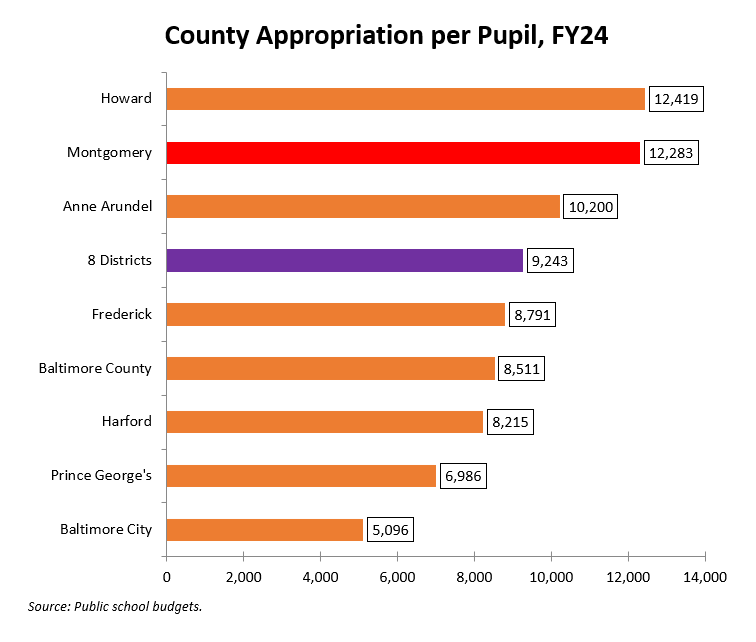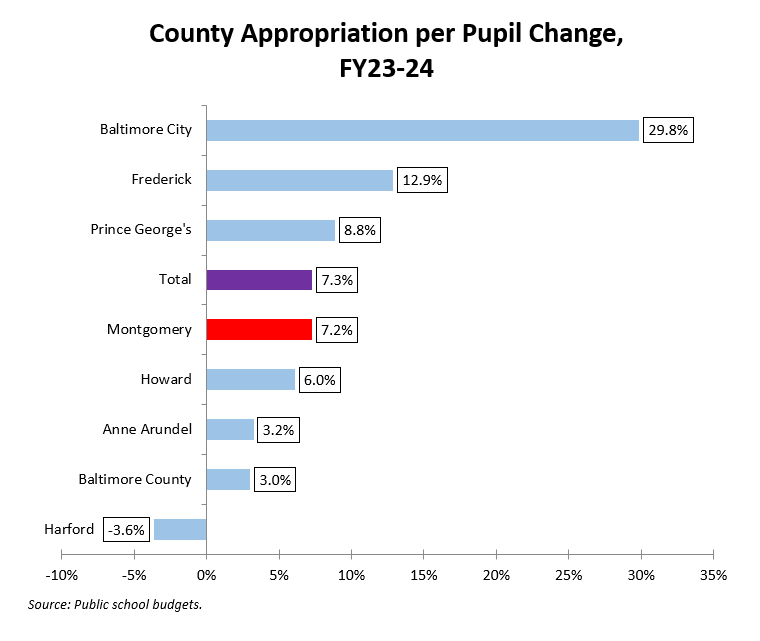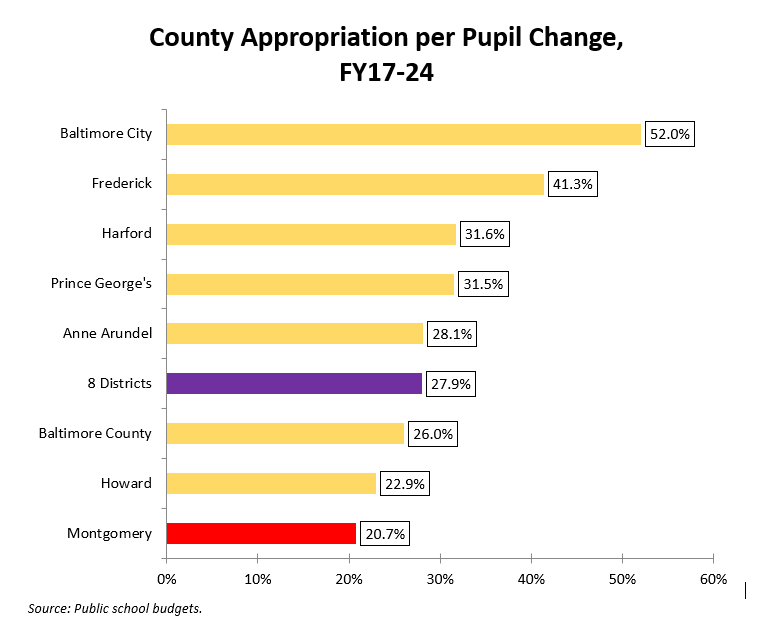By Adam Pagnucco.
In Part Four, we looked at growth in county appropriations to schools. Today we will look at county appropriations per pupil.
Let’s start with county appropriations per pupil in the current fiscal year, FY24.

MoCo ranks near the top on this measure, partially because state aid is driven by wealth measures and disproportionately goes towards less affluent jurisdictions like Baltimore City and Prince George’s County. MoCo taxpayers make up the difference.
Now let’s look at the growth in county appropriations per pupil from FY23 through FY24.

A note about Harford County. The enrollment estimate I’m using here is based on a projection so it’s possible that their appropriation per pupil will ultimately have a small increase and not a decrease. Their FY24 schools budget claims that the county went over the state’s maintenance of effort requirement by $10 million.
MoCo’s increase was above inflation but below Prince George’s and Frederick and waaaaay below Baltimore City. We will explain why in a minute. But first, let’s look at the growth in this measure since FY17.

MoCo is at the bottom on this measure. Baltimore City is at the top.
What explains this? A big factor in what’s going on here is the state’s Blueprint program for schools, which increases state aid but also mandates additional local money in some jurisdictions. The Blueprint hit Baltimore City and Prince George’s County hard this year. The FY24 Baltimore City budget said this about the Blueprint:
Public schools in Maryland are funded by both local governments and the State. Prior to Fiscal 2023, local government contributions were determined by Maintenance of Effort (MOE), a formula that required appropriating at least the same level of funding on a per pupil basis as the prior year. In 2020, the Maryland General Assembly passed the Blueprint for Maryland’s Future, commonly referred to as Kirwan, which implemented the recommendations of the Commission on Innovation and Excellence in Education, or the Kirwan Commission…
The Blueprint dramatically changed the education funding formula in Maryland and will continue to significantly impact the City’s required contribution to City Schools.
Baltimore City elaborated:
In Fiscal 2023, the State and Local Share for schools were established through State law rather than utilizing the education funding formula. Fiscal 2024 is the first year of using the formula to set the State and Local Share amounts for schools. Based on the results of the formula, the City’s Local Share is growing at a much higher rate than what was assumed in the initial projections from the Blueprint legislation.
Prince George’s County Executive Angela Alsobrooks wrote this about the Blueprint in her FY24 proposed budget:
This year’s budget was particularly difficult to navigate, and like many families sitting around the kitchen table, we had to make difficult choices. That’s because the new funding obligations for the Blueprint for Maryland’s Future (Kirwan) have begun, and we are legally mandated this year to provide an additional $88.4 million to our school system. With $180 million in new revenues this year, that equates to half of our new revenues being legally mandated to go to our school system, before we do anything else. The rest of those new revenues are going to areas where we need to improve basic government services for our residents to meet their immediate needs and helping our County long-term to grow revenues and minimize the impact of Kirwan on our budget for the next decade.
So in these cases, it’s not that politicians in Baltimore City and Prince George’s County are more friendly to public schools than MoCo politicians. Rather, they are being forced to spend more on schools by the state – and they don’t like it.
As for Frederick County, it restructured its income tax brackets to produce a net revenue increase, which helped it put more money into schools. According to the county’s FY24 budget: “Overall, the new rates did increase the budgeted amount, but the primary reason is continued growth in the underlying income growth of residents.”
So the story for MoCo on school funding is a mixed bag. The county has done well compared to its peers in the last two years. But it ranks near the bottom over the longer term. Part of the reason is that the state’s Blueprint law is beginning to squeeze other jurisdictions hard, particularly Baltimore City and Prince George’s County, and may one day affect MoCo’s budget.
All of this said, none of this addresses how the schools spend your money. I have previously found that many large school districts carry enormous fund balances which dwarf MCPS. Additionally, MCPS regularly transfers instructional salary money towards other uses, a practice which I suspect occurs elsewhere in Maryland. So yes, let’s increase funding for schools, but let’s also watch closely how that money is spent.
